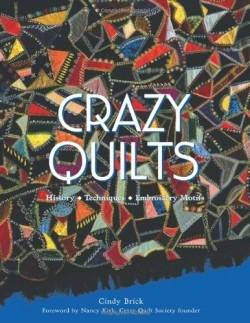Crazy Quilts
History, Techniques, and Embroidery Motifs
In 1816 a patent was granted for the kaleidoscope, and within twenty years the toy became so popular that its colorful, random patterns inspired designs for home decorations from stained glass to dishes. Perhaps it inspired America’s earliest known Crazy quilt as well. The Maryland Kaleidoscope, dated 1839, is a jumble of irregular-shaped patches creating a chaotic, yet beautiful covering.
Brick guides the reader through a history of these unique quilts that “considers not only what was being made and when—but also why.” She is a writer, editor, teacher, textiles appraiser, and professional quilt restorer who has contributed to nearly every quilt entry in the Encyclopaedia Britannica and authored four other books, including Hanky-Panky Crazy Quilts. With this extensive knowledge behind her, Brick offers an engaging look at this once practical household item that today is considered a work of art.
The rejection of traditional patchwork patterns is the most obvious feature of Crazies, but over time additional features would come and go. During the Civil War, while the men were away fighting and new fabric was hard to come by, women would sew quilts using from pieces in their scrap bags, then spend hours adding elaborate embroidery, appliqués, and quilting to keep their minds off their worries. These additions would reappear during the Crazy’s heyday a couple decades later, with Victorian women proving their needlework skills using exquisite silk in velvets, satins, and more. Every seam was embroidered, and patches were embellished with stitches, paints, and beads. Influenced by the Aesthetic design movement of the time, Crazy quilts became works of art that moved from simply covering beds to being displayed in the parlors of well-to-do Victorians.
Viewing the multitude of full-color photographs of quilts and ephemera may induce a desire to create a Crazy, and Brick obliges the reader in this respect. Part Two of the book is a how-to guide covering traditional piecing as well as paper foundation and shadow piecing. Included are also forty-five antique embroidery motifs that can be copied and stitched. This wealth of information will appeal to and inspire beginning and experienced quilters alike. “You can do it,” Brick encourages. “You can make a Crazy. May your quilt be full of beauty—and special memories for you and your family.”
Reviewed by
Christine Canfield
Disclosure: This article is not an endorsement, but a review. The publisher of this book provided free copies of the book to have their book reviewed by a professional reviewer. No fee was paid by the publisher for this review. Foreword Reviews only recommends books that we love. Foreword Magazine, Inc. is disclosing this in accordance with the Federal Trade Commission’s 16 CFR, Part 255.


